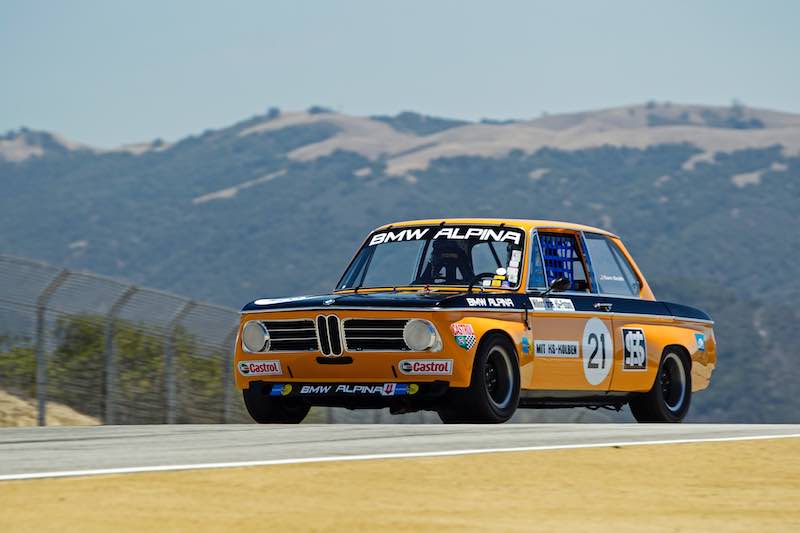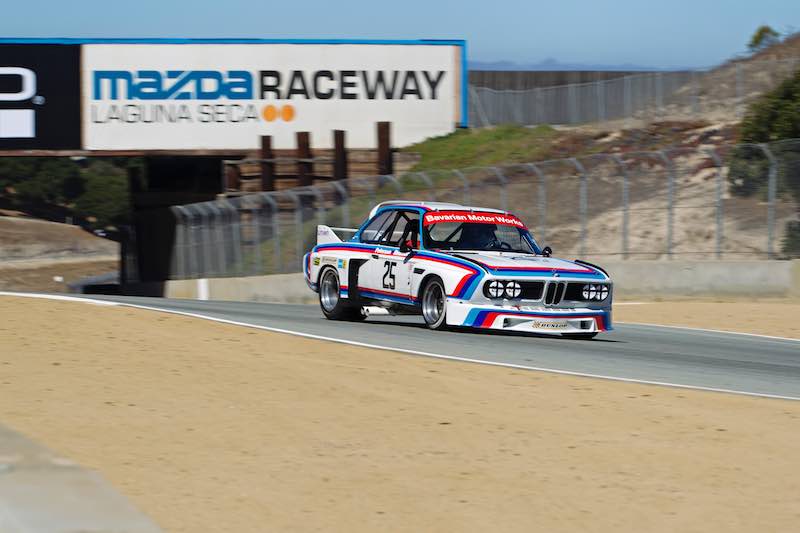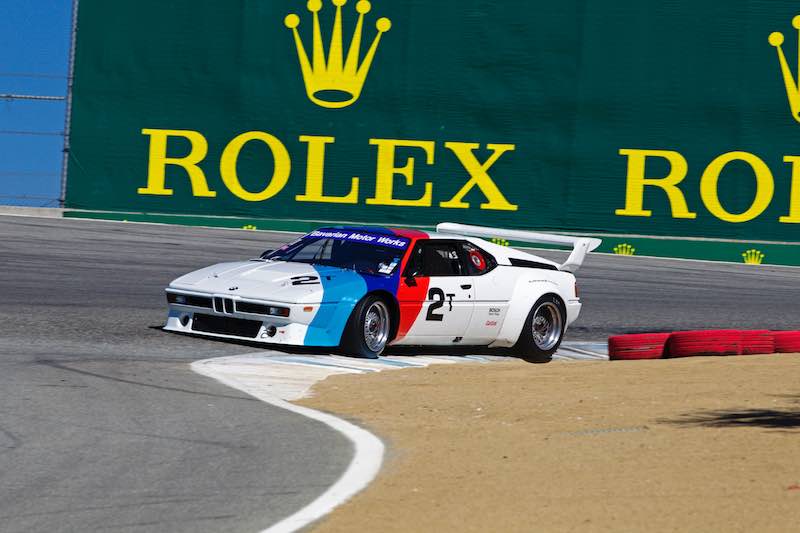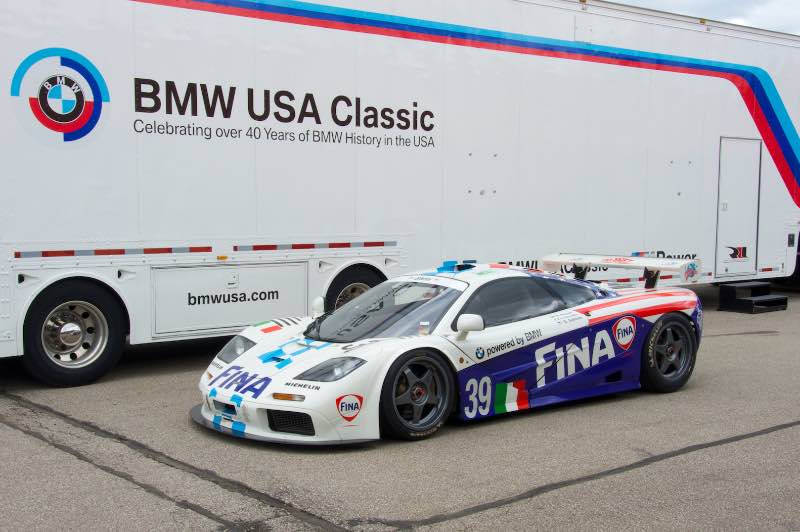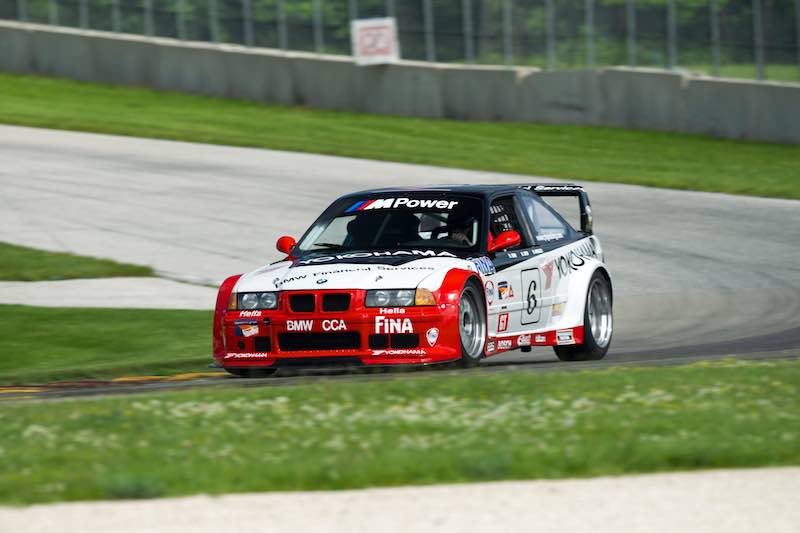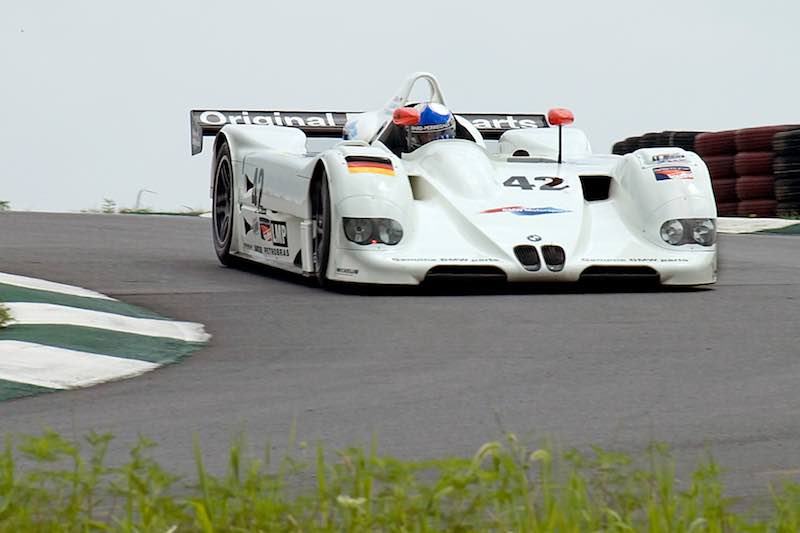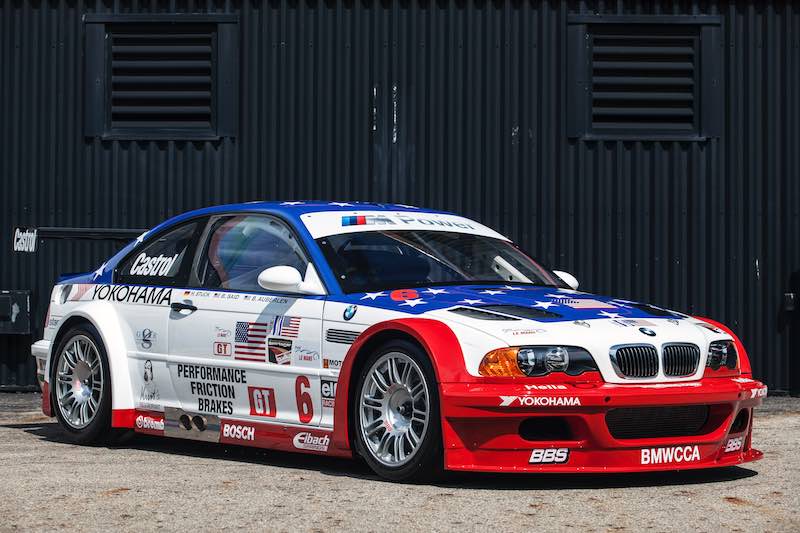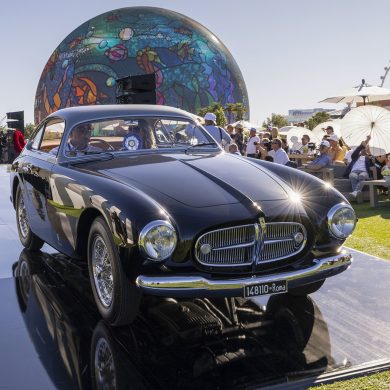BMW USA Classic will run seven historic race cars at the 2016 Monterey Motorsports Reunion, to be held August 18-21 at Mazda Raceway Laguna Seca in California during Monterey Classic Car Week. BMW is the featured marque at the Rolex Reunion and the brand will be represented by 64 vintage BMW race cars ranging from a group of 1930’s 328s to the all-conquering BMW V12 LMR of 1999. The Rolex Reunion promises to be the largest gathering of BMW M1 ProCars ever assembled in the USA. Finally, all five factory IMSA specification 3.0 CSLs will be back together for the first time since they raced in 1975 and 1976.
Rather than a static heritage display that is typical for the featured marque at the Monterey Motorsports Reunion, BMW of North America has developed the ‘BMW Living Legends Garage’ to house a selection of BMW’s that chronicle the history of the company’s racing heritage. Many of these cars will be actively competing in the racing action throughout the weekend so visitors will be able to see, hear and feel the living history of the brand.
Among the 64 BMWs racing in the Rolex Reunion will be seven cars from the BMW USA Classic collection. Drivers will include BMW of North America Chairman Ludwig Willisch and several past and current BMW Motorsport drivers.
1970 BMW Alpina 2002 Ti
The BMW 2002ti was a higher performance version of the BMW’s compact sports sedan. The ‘ti’ meaning ‘Touring Internationale’ featured twin two-barrel Solex sidedraft carburetors, front and rear sway bars, higher performance tires, and a 5-speed gearbox provided the perfect platform for sport car racing in Europe in the late Sixties and early Seventies.
This racing 2002 ti was built by German BMW constructor/tuner/race team ALPINA GmbH in 1970 and features ALPINA’s signature Weber side draft carburetors, engine upgrades, flared fenders and three-piece ALPINA alloy wheels. In late 1970, the car was sold to Vasek Polak BMW of Hermosa Beach, California. The car was then campaigned by Competition of Torrance in SCCA events for the 1971 and 1972 seasons and before retiring.
The car spent the next 24 years in storage before being purchased by BMW of North America, completely reconditioned and painted in non-period-correct BMW Motorsport livery and entered for the BMW celebration at the 1996 Monterey Historic Races. Nick Craw, John Morton, Danica Patrick, Boris Said, Bill Auberlen and Tommy Milner have all vintage raced the car since its rebirth.
In early 2014, the car was restored to its original 1970 BMW ALPINA Team Orange with Semi-Gloss Black hood and rear deck livery with the help of ALPINA GmbH. At this years Rolex Reunion, the BMW ALPINA 2002ti will be driven by Road & Track Editor Sam Smith in Group 3B: 1963-1973 FIA Manufacturers Championship with races on Sunday, August 21.
1975 BMW 3.0 CSL IMSA Group 4 No. 25
The 3.0 CSL race cars were the first cars to be developed under the new BMW Motorsport GmbH subsidiary, established in 1972 and led by Jochen Neerpasch. They were also the first to sport the new official colors of BMW Motorsport — red, purple and blue.
Based on the production 3.0 CS coupe, the aluminum skinned CSL (L = lightweight) homologation special, nicknamed the ‘Batmobile’ by its fans, formed the basis for an assault on Group 2 through Group 5 European touring car racing that would make it one of the most successful production racers of all time. In fact, CSL’s continued to win races into the late 1970’s, even though production ended in 1975 to make way for its successor, the BMW 6 Series.
Throughout its span of development, the BMW inline 6-cylinder engine, a 3.0 liter unit in the production car, grew from 3.2 to 3.5 liters, increasing in horsepower from 340 to 430 bhp, thanks to the development of a four-valve cylinder head.
This 3.0 CSL (Chassis No. 2275985) was one of a group of five chassis campaigned in North America in the 1975 & ’76 IMSA Camel GT Series in Group 4 specifications. The CSL enjoyed considerable success winning at Sebring, Riverside, Laguna Seca, Daytona and Talladega in 1975. In 1976, Chassis No. 2275987 campaigned as the #59 car driven by Peter Gregg, Brian Redman and John Fitzpatrick won the 24 Hours of of Daytona. Several iconic drivers were involved in the American success of the CSL’s, including Hans Stuck, Sam Posey, Brian Redman, Ronnie Peterson, Dieter Quester, Benny Parsons, Peter Gregg and David Hobbs. All five chassis are still in existence and are expected to be reunited in Monterey.
At the Rolex Reunion, the BMW 3.0 CSL No. 25 will be driven by BMW of North America President and CEO, Ludwig Willisch. Willisch will run in Group 4A: 1973-1981 FIA, IMSA with races on Saturday, August 20.
1981 BMW M1 IMSA Group 4 No. 2
As racing regulations evolved in the mid-Seventies, BMW Motorsport saw an opportunity to challenge arch-rival Porsche in a new racing series by designing and manufacturing a purpose-built race car and offering a street version for sale to the public, as stipulated by the rules. The BMW M1, designed by Giorgetto Giugiaro and powered by a Paul Rosche-designed 3.5-liter, twin-cam 6-cylinder “M88” engine, mounted amid-ship, debuted at the 1978 Paris Auto Show to the admiration of the world’s motoring press. However, development and production delays with outside contractors caused its appearance to coincide with the demise of the racing formula for which it was created. The quick thinking solution was the fast and furious ProCar Series which preceded European Formula 1 races.
A few of the M1 ProCars were imported to the US, modified for endurance racing and successfully raced in the popular IMSA GTO Series. BMW of North America only entered its M1 IMSA Group 4 in the longer races of the 1981 season driven by the likes of David Hobbs, Mark Surer, and Dieter Quester as the company’s racing program shifted focus to the new M1/C prototype for the shorter races. This M1 IMSA Group 4 (Chassis No. 4301223) was the spare car for the BMW of North America team and appears to have seen limited racing action. The No. 2 M1 IMSA Group 4 will be driven by The Drive auto tester Lawrence Ulrich. Ulrich will also run in Group 4A with Willisch in two races on Saturday, August 20.
1996 McLaren F1 GTR Powered by BMW
The 1992 – 1998 McLaren F1 was the world’s fastest and most technically advanced production car in its day. On 31 March 1998, a McLaren F1 set the record for the world’s fastest production car, reaching 231 mph (372 km/h). The car was the first to feature a fully carbon fiber structure, a stressed engine and many other advanced racing technologies adapted for the street – which all helped to minimize weight. McLaren turned to BMW to develop an engine worthy of this supercar and BMW responded by developing a naturally aspirated 6.0-liter, twin-cam, 4 valve, V-12, developing 636 horsepower. Production began in 1992 and ended in 1998. In all, 106 cars were manufactured, 64 of which were the standard street version (F1), five were LMs (tuned versions), three were longtail roadcars (GT), five prototypes (XP), 28 racecars (GTR) and one LM prototype (XP LM).
The McLaren F1 featured one seat more than most similar sports cars, with the driver’s seat located in the center (and slightly forward) of two passengers’ seating positions, providing driver visibility superior to that of a conventional layout.
Despite not having been designed as a race car, the race versions of the F1 (F1 GTR) have had fantastic racing success, including the 24 Hours of Le Mans in its first try in 1995, where it faced purpose-built prototype race cars. The F1 GTR differs only slightly from the production car. In 1995, McLaren F1 GTRs also won the 1000 kilometer race at Suzuka and the 4-Hours of Silverstone.
In 1996-97-98, McLaren F1 GTRs again took on the challenge of Le Mans, finishing 4th, 2nd, and 4th overall respectively. This car, chassis #17R sponsored by BMW of North America, had a three race career in 1996. The first was the Pre-Le Mans race in May ‘96 where it finished in 13th place driven by Steve Soper and Jacques Laffite. It then ran in the Silverstone 4 Hours and finished 4th at the hands of Steve Soper and Nelson Piquet. The third and final competition the car saw was the 1996 edition of the 24 hours of Le Mans. After running as high as 3rd overall, #017R driven by Nelson Piquet, Danny Sullivan, and Johnny Cecotto finished in 8th place overall.
After the 1996 Le Mans race, the car was retired and remains in original/unrestored condition. At the 2016 Rolex Reunion, it will be driven by retired pro driver and television announcer Justin Bell who drove a sister McLaren F1 GTR to third overall at the 1995 24 Hours of Le Mans. Bell will run in Group 5B: 1981-1991 FIA manufacturers Championship, IMSA GTO/GTP with races on Sunday, August 21.
1998 BMW (E36) M3 GT-2
This car is one of the specially prepared BMW M3 race cars that won both the 1997 and 1998 Drivers’ and Manufacturers’ Championship in PSCR SportsCar GT-2 category for production-based cars. This car and its teammates won 17 straight races in these seasons. This chassis won its class at both the 12 Hours of Sebring in 1998 and the 24 Hours of Daytona in 1997.
Based on the popular high-performance (E36) M3 coupe, these purposeful machines were equipped with race-tuned versions of the 3.2-liter inline 6-cylinder engine production engine. Removal of normal road equipment such as VANOS, air conditioning, audio system, anti-lock braking system, sound insulation, interior etc. reduces vehicle weight to around 2350 pounds contributing to a favorable power-to-weight ratio in their racing class. Engine power reaches a peak of 425 hp; with top speeds ranging up to 175 mph, according to gearing selected for specific racetracks.
Among drivers that campaigned the M3’s are Pete Halsmer, Derek Hill, John Paul Jr., David Donahue, Mark Duez, Dieter Quester, Hans Stuck, Boris Said III, Mark Simo, Justin Bell, Peter Cunningham, and Bill Auberlen.
Current BMW Motorsport driver John Edwards will have the honor of driving the Simo/Said/Auberlen car for the Rolex Reunion. Edwards will run in Group 5B: 1981-1991 FIA manufacturers Championship, IMSA GTO/GTP with races on Sunday, August 21st.
1999 BMW V12 LMR
Jointly developed with Formula 1 partner WilliamsF1, the BMW V12 LMR was built to challenge the 1999 24 Hours of Le Mans and ALMS Series .
The V12 LMR you see here debuted at the American Le Man Series 12 Hours of Sebring in March of 1999. Driven by Tom Kristensen (DK), JJ Lehto (F) and Jorg Muller (D), the car won the race overall in the closest finish up to that time, a mere 9.2 seconds separating first and second place.
Carrying inspiration from that victory to Le Mans, the V12 LMR of Yannick Dalmas (F), Pierluigi Martini (I) and Joachim Winkelhock (D) drove to the front of the field and gave BMW its first and only overall victory at Le Mans in 1999. This was the first racing car since 1987 to win both the Sebring and Le Mans classics in the same year.
The BMW V12 LMR continued to compete in ALMS, winning races in 1999 at Sears Point, Laguna Seca, and Las Vegas – finishing second at Portland and Road Atlanta. In its second year of ALMS competition, the car won twice at Charlotte and Silverstone.
Retiring only twice for mechanical fault in eighteen races entered, this V12 LMR is a testament to BMW’s commitment to advanced automotive design and technology. In total, five chassis were produced with only four remaining.
BMW ace driver Bill Auberlen will be reunited with the LMR for the Rolex Reunion this year. Auberlen will run in Group 5B: 1981-1991 FIA manufacturers Championship, IMSA GTO/GTP with races on Sunday, August 21st.
2001 BMW (E46) M3 GTR V8
The BMW M3 GTR was a dominant competitor throughout the single season that it contested. Bill Auberlen, Boris Said and Hans J-Stuck capped off the season for BMW North America by winning the 2001 Petit Le Mans finale. As a tribute to a grieving nation and to those who lost their lives in 9/11, BMW Team PTG owner Tom Milner had created the patriotic “Stars and Stripes” design specifically for this race. As a result of the win and the special livery, the car became a legend for BMW racing fans in America.
The most unique feature of the M3 GTR was its powerplant, the first M3 in the history of the company to feature a V8 engine. Designated “P60” the 4.0-liter engine was the first engine designed and constructed by BMW Motorsport specifically as a race engine. This unique engine was smaller and weighed 30 pounds less than the inline 6-cylinder of the regular M3, despite adding two cylinders. Featuring a dry sump for optimal lubrication at high cornering loads and a “flat plane” crankshaft, the design allowed for more efficient exhaust scavenging without the need to have header primaries cross over from one bank to the other enabling optimal flow at high rpms. This resulted in a very reliable 444 horsepower at 7500 rpm in race trim.
Controversial during its only season of American Le Mans competition, the M3 GTR was built to a set of rules that ultimately existed for only one season and allowed a manufacturer to compete with a purpose-built racing engine as long as a (small) number of road cars were produced. Two M3 GTR race cars each were campaigned by BMW Team PTG and BMW Team Schnitzer beginning with the third event of the eight race ALMS season. The two squads, for all intents and purposes now only competing amongst themselves, combined to win the final six races in a row, from five pole positions while setting six new race lap records. The BMW M3 GTR easily secured the ALMS Manufacturers’ Championship for BMW, the Team Championship for BMW Team Schnitzer and the Drivers’ Championship for Jörg Müller.
This car, chassis M3-GTR-006, powered by the P60 V8 engine is also one of the BMW Team PTG M3s that swept the Manufacturer, Driver and Team GT class championships in the 2004 Rolex Sports Car Series. Winning 10 of 12 races, including six 1-2 podium finishes.
Chassis 006 has now been returned to its most memorable configuration and livery in honor of BMW of North America’s 40th Anniversary. 006 has undergone an 18-month ground-up restoration by BMW USA Classic partner Rahal Letterman Lanigan (RLL) with invaluable assistance from former PTG team members and BMW Motorsport and remains a part of the BMW USA Classic Collection.
Longtime BMW driver and dealer Boris Said will be reunited with the Stars & Stripes GTR for the Rolex Reunion this year. Said will run in Group 5B: 1981-1991 FIA manufacturers Championship, IMSA GTO/GTP with races on Sunday, August 21.
[Source: BMW USA]


